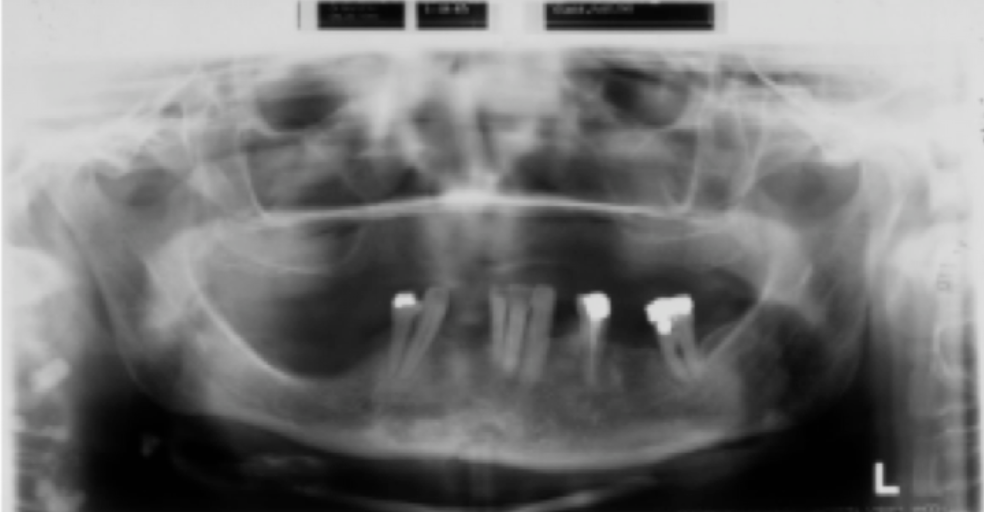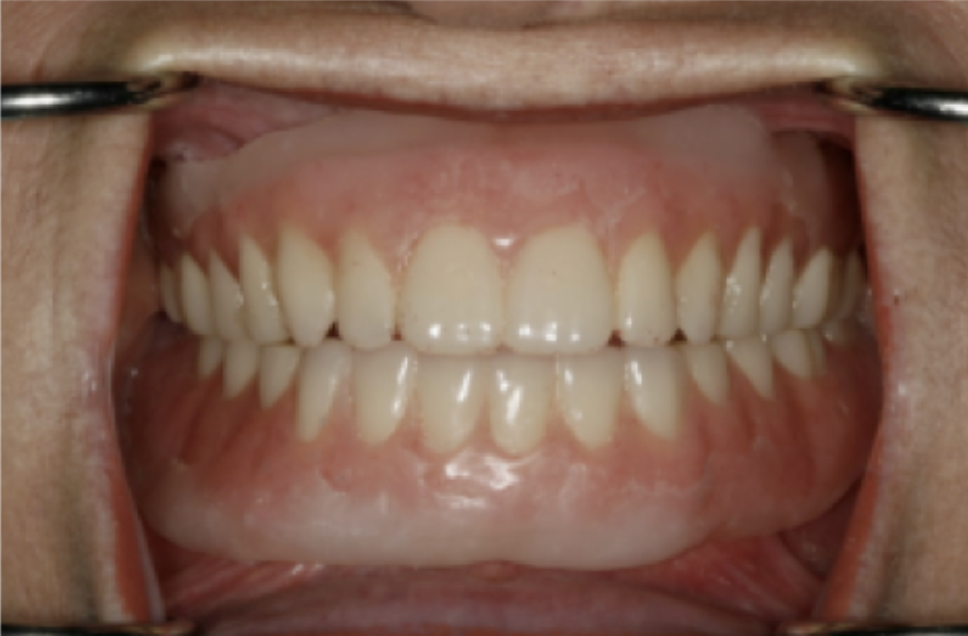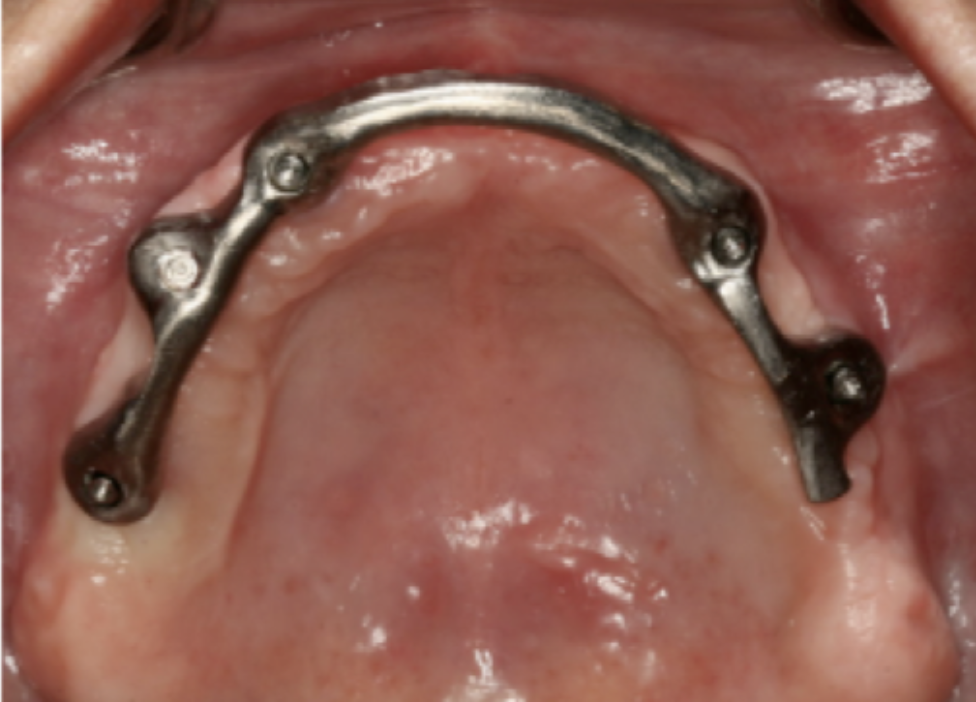Treatment Process
The patient is a female in her early 60’s who has been wearing a complete denture for nearly 40 years on her upper jaw. She has a partial complement of teeth in her lower jaw that was supporting a removable partial denture. She has had several replacement dentures and partial dentures fabricated in the past. She presents wishing to receive a more serviceable and esthetic prosthesis.

This case study demonstrates full mouth reconstruction with dental implants. The upper prosthesis was supported with a metal bar attached to implants, and was removable by the patient for cleanability purposes, while the lower was fixed in place for the patient, but able to be removed by the dentist for maintenance purposes.

Examination of esthetic parameters reveals upper teeth positioned outside normal limits, which gives a very unnatural and “fake” appearance to the prosthesis.

Profile view of the patients teeth.

Examination of the upper and lower jaws without both prostheses in place, reveals compromised teeth on the lower jaw from a standpoint of structure, periodontal disease, dental decay, and poor positioning, that do not lend them to being strategic teeth to support a future prosthesis. The upper jaw is very atrophic from long term tooth loss and denture use, and is also not very serviceable for supporting a prosthesis without the aid of dental implants.

A view of the compromised lower jaw.

A view of the compromised upper jaw. The physiology of the human body is such that when tooth loss occurs, bone and tissue loss will occur over the course of many years. Use of a denture additionally will accelerate this process, and render a denture bearing jaw unserviceable for supporting and retaining a denture after many years of use. Use of dental implants are beneficial to this cause, because the body will continue to maintain bone around implants, similar to that of a tooth, and will prevent long term bone loss.

Preoperative panoramic radiograph, demonstrating severe bone loss of the upper jaw, and periodontal disease of the lower jaw.

The first stage of treatment was extraction of the remaining lower teeth, and bone grafting of the upper jaw to provide the necessary bone to anchor future dental implants. Because the upper jaw was extremely deficient of bone, bone was transplanted from the patient’s hip to the upper jaw. After 8 weeks of initial healing, the patient was able to wear immediate “healing” dentures on the upper and lower jaws. Multiple tissue liners were placed on the tissue bearing surfaces of both during the healing process, to help maintain function and comfort. Bone used for grafting may be used from a variety of sources: the patient’s own bone, sterilized cadaver bone, bone grafting procedures are starting to eliminate the more invasive bone grafting procedures.

Immediate “healing” dentures in place.

Dental implants were placed after 4 months of healing following bone grafting on the upper and lower jaws. 2 months following implant placement, the lower denture was converted to an interim fixed prosthesis anchored to the lower implants. The implants on the upper jaw required more healing time because they were placed in grafted bone. Conversion of the lower implants was done to provide the patient with much better function until the final prosthesis was able to be made. The white “domes’ seen on the upper jaw are healing caps attached to the dental implants.

4 months following placement of the dental implants on the upper jaw, a titanium bar was fabricated using state-of-the-art milling technology to provide an extremely accurate fit to the 5 implants. This bar will be used to support and retain a removable prosthesis, but was for this patient because the implants were placed in grafted bone. Grafted bone does not anchor implants quire as well as a body’s native bone would, so more implants and splinting with a bar is typically done to provide for a more predictable long term prognosis, when the implants are placed in grafted bone. A titanium alloy is the metal of choice due to biocompatibility and strength.

Final upper prosthesis in place. When a sufficient number of dental implants are utilized on the upper jaw, the palate portion that typically covers the roof of the mouth can be removed. This allows for a less cumbersome prosthesis, as well as allows the patient to taste more, because some of the minor taste buds housed in the roof of the mouth can now be exposed to food during eating. The small gold colored pins seen on the back outer portions of the prosthesis are used to anchor the prosthetic to the bar. This one of many attachment systems used to serve this purpose. A removable prosthesis was used on the upper arch because a “flange” was used to support the upper lip to provide for acceptable esthetics. Whenever a flange is used, the prosthesis becomes uncleansable if it is not able to be removed daily by the patient. In most situations like this, when teeth have been absent for a period of time, a flange is required to provide adequate support of the upper lip.

View of lower fixed-implant supported overdenture. Because a flange was not necessary on the lower arch, a fixed prosthesis was able to be provided with acceptable access for daily hygiene practices. This prosthesis is able to be removed easily by the dentist if needed for repair/maintenance purposes, although it is not removed by the patient. The understructure of this prosthesis is also a milled titanium framework, to provide maximum strength and resistance to fracture.

Panoramic radiograph post treatment showing the dental implants and prosthetic hardware in place, versus pretreatment.

Smile with final implant prostheses in place.

Smile with final implant prostheses in place.

Before and after profile views demonstrating the remarkable esthetic improvement, due to appropriate tooth positioning of the upper front teeth.

Full face smile with final implant prostheses in place.

Ready to Start Your journey?
At Meng Dentistry we welcome all dental patients including those needing more complex dentistry. We provide the full range of Prosthodontics, cosmetic dentistry, and general dentistry including, teeth whitening, esthetic bonding, dental veneers, crowns, bridges, removable prostheses (dentures and partials), maxillofacial prosthodontics (obturators), and dental implants. Call today to see how Meng Dentistry can transform your smile!

